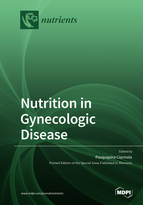Nutrition in Gynecologic Disease
A special issue of Nutrients (ISSN 2072-6643). This special issue belongs to the section "Nutrition in Women".
Deadline for manuscript submissions: closed (31 July 2021) | Viewed by 124684
Special Issue Editor
Interests: nutrition in women; reproductive medicine; obstetric delivery; reproductive biology; fetal growth restriction; prenatal diagnosis; screening; RNA; immunohistochemistry; gene expression; cells
Special Issues, Collections and Topics in MDPI journals
Special Issue Information
Dear Colleagues,
The pathologies concerning the gynecological organs are very varied and range from tumoral pathologies to hormonal dysfunctions. The frequency of benign and malignant disease affecting women’s health is very high. These include ovarian, endometrial, and cervical cancer, as well as gynecological benign diseases such as PCOS, endometriosis, and uterine leiomyoma.
Epidemiological studies show that lifestyle can be an important risk factor for gynecological diseases. One such modifiable lifestyle factor is the diet. The father of medicine, Hippocrates, proclaimed “Let food be thy medicine and medicine be thy food” almost 25 centuries ago. The relationship between diet and health is yet to be fully explored. The human diet contains a wide variety of plant-based foods that provide essential nutrients for the body. Besides, plant-based foods possess a huge variety of non-nutritive components that offer beneficial health effects.
This Special Issue aims to bring together the latest knowledge regarding the nutrition therapy of gynecological diseases, which will offer valuable insight into how diet as a whole, nutraceuticals, nutrients, dietary patterns, phytochemicals, or other dietary components can serve as preventive and/or therapeutic compounds. Contributions regarding the utility of nutrients in the management of menopause, reproductive disfunction, and the obstetric outcomes are also welcome.
Prof. Dr. Pasquapina Ciarmela
Guest Editor
Manuscript Submission Information
Manuscripts should be submitted online at www.mdpi.com by registering and logging in to this website. Once you are registered, click here to go to the submission form. Manuscripts can be submitted until the deadline. All submissions that pass pre-check are peer-reviewed. Accepted papers will be published continuously in the journal (as soon as accepted) and will be listed together on the special issue website. Research articles, review articles as well as short communications are invited. For planned papers, a title and short abstract (about 100 words) can be sent to the Editorial Office for announcement on this website.
Submitted manuscripts should not have been published previously, nor be under consideration for publication elsewhere (except conference proceedings papers). All manuscripts are thoroughly refereed through a single-blind peer-review process. A guide for authors and other relevant information for submission of manuscripts is available on the Instructions for Authors page. Nutrients is an international peer-reviewed open access semimonthly journal published by MDPI.
Please visit the Instructions for Authors page before submitting a manuscript. The Article Processing Charge (APC) for publication in this open access journal is 2900 CHF (Swiss Francs). Submitted papers should be well formatted and use good English. Authors may use MDPI's English editing service prior to publication or during author revisions.
Keywords
- gynecologic disease
- nutrients
- uterus
- ovary







